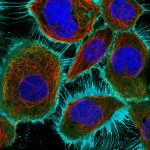Lien vers Pubmed [PMID] – 29689230
Curr. Biol. 2018 Apr;28(8):R458-R470
Cells don’t simply separate at cytokinesis. While furrow contraction critically relies on myosin-II and F-actin, post-furrowing steps are less understood but involve the constriction of ESCRT-III polymer-dependent helices on the side of the midbody, which likely drive final abscission. The first evidence that animal cell cytokinesis requires membrane traffic, as in plant cells, was provided about 15 years ago. Since then, it has become increasingly clear that fusion of vesicles to the cytokinetic furrow is essential in large embryonic cells, and that membrane traffic within the intercellular bridge is crucial for its stability and successful abscission in all animal cells. Here, we review our current knowledge of the secretory and endocytic recycling pathways involved in cytokinesis, and how vesicles defined by specific Rab and Arf GTPases are targeted and fused to the membrane of the intercellular bridge thanks to different molecular motors, tethering complexes and SNARE machineries. At the functional level, we will describe how membrane traffic can remodel both phosphoinositide lipids and promote F-actin clearance necessary for ESCRT-III-dependent abscission, and identify key unanswered questions in the field. We will finally review recent evidence showing a tight coupling between membrane traffic and cytokinesis in complex processes, such as during the establishment of de novo apico-basal polarity.
